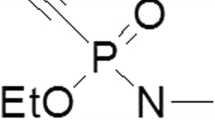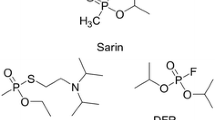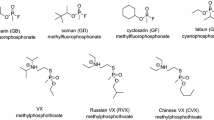Abstract
Introduction
A non-toxic and stable sarin analogue, isopropyl p-nitrophenyl methylphosphonate (INMP), was synthesized for safe preparation of sarin-exposed acetylcholinesterase (AChE).
Results and Discussion
This agent was stable for years, able to be handled in an ordinary laboratory without special care, and its 50% inhibitory concentration (IC50) on 0.04 U/ml human erythrocytes AChE was 15 nM. This reagent was thought to be especially useful since it enables experiments that require sarin-inhibited AChE, such as the development of antidotes for sarin, in a usual laboratory. To demonstrate the usefulness of this method, 40 known and novel pyridinealdoxime methiodide (PAM)-type oxime antidotes were synthesized, and their reactivation activities to INMP-exposed AChE and structure–activities correlation were studied.
Conclusion
Among the antidotes tested in this experiment except for 2-PAM, the compound found to have the highest reactivation activity, was the novel hydrophobic 2-PAM-type compound, 2-[(hydroxyimino)methyl]-1-[4-(tert-butyl)benzyl] pyridinium bromide.






Similar content being viewed by others
Abbreviations
- AChE:
-
acetylcholinesterase
- BBB:
-
blood–brain barrier
- BIMP:
-
bis(isopropyl methylphosphonate)
- CH2Cl2 :
-
dichloromethane
- DCC:
-
dicyclohexylcarbodiimide
- DCU:
-
dicyclohexylurea
- DMAP:
-
dimethylaminopyridine
- IC50 :
-
50% inhibitory concentration
- IMPA:
-
methylphosphonic acid monoisopropyl ester
- INMP:
-
isopropyl p-nitrophenyl methylphosphonate
- LC–ESI-MS:
-
liquid chromatography–electrospray mass spectrometry
- NMR:
-
nuclear magnetic resonance
- PAM:
-
pyridinealdoxime methiodide
- pK a :
-
dissociation constant
- RT:
-
room temperature
- THF:
-
tetrahydrofuran
- TLC:
-
thin-layer chromatography
References
T. Suzuki, H. Morita, K. Ono, K. Maekawa, R. Nagai, and Y. Yazaki. Sarin poisoning in Tokyo subway. Lancet 345:980 (1995).
N. Masuda, M. Takatsu, H. Morinari, and T. Ozawa. Sarin poisoning in Tokyo subway. Lancet 345:1446 (1995).
H. Nozaki and N. Aikawa. Sarin poisoning in Tokyo subway. Lancet 345:1446 (1995).
M. Nagao, T. Takatori, Y. Matsuda, M. Nakajima, H. Iwase, K. Iwadate, and T. Amano. Detection of sarin hydrolysis products from sarin-like organophosphorus agent-exposed human erythrocytes. J. Chromatogr. B 701:9–17 (1997).
M. Nagao, T. Takatori, Y. Matsuda, M. Nakajima, H. Iwase, and K. Iwadate. Definitive evidence for the acute sarin poisoning diagnosis in the Tokyo subway. Toxicol. Appl. Pharmacol. 144:198–203 (1997).
Y. Matsuda, M. Nagao, T. Takatori, H. Niijima, M. Nakajima, H. Iwase, M. Kobayashi, and K. Iwadate. Detection of the sarin hydrolysis product in formalin-fixed brain tissues of victims of the Tokyo subway terrorist attack. Toxicol. Appl. Pharmacol. 150:310–320 (1997).
K. Sakurada, K. Matsubara, K. Shimizu, H. Shiono, Y. Seto, K. Tsuge, M. Yoshino, I. Sakai, H. Mukoyama, and T. Takatori. Pralidoxime iodide (2-PAM) penetrates across the blood–brain barrier. Neurochem. Res. 28(9):1401–1407 (2003).
S. N. Dube, R. Bhattacharya, K. Husain, and A. K. Sikder. Enzymes of the Cholinesterase Family:Proceedings of the Fifth International Meeting on Cholinesterases Held in Madras, India, September 24–28, 1994, Kluwer, Boston, Massachusetts, 1995, pp. 375–379.
L. P. A. De Jong, H. P. Benschop, G. R. Van den Berg, G. Z. Wolring, and D. C. De Korte. Reactivation of tabun-inhibited acetylcholinesterase by 1-(hetero)-arylmethylpyridinium oximes. Eur. J. Med. Chem. 16(3):257–262 (1981).
M. Kataoka, N. Tsunoda, H. Ohta, K. Tsuge, H. Takesako, and Y. Seto. Effect of cation-exchange pretreatment of aqueous soil extracts on the gas chromatographic–mass spectrometric determination of nerve agent hydrolysis products after tert.-butyldimethylsilylation. J. Chromatgr. A 824:211–221 (1998).
G. L. Ellman, K. D. Courtney, V. Andres Jr., and R. M. Featherstone. A new and rapid colorimetric determination of acetylcholinesterase activity. Biochem. Pharmacol. 7:88–95 (1961).
S. P. Katrolia, A. K. Sikder, J. Acharya, N. Sikder, D. K. Jaiswal, R. Bhattacharya, K. Husain, S. N. Dube, D. Kumar, and S. Das Gupta. Antidotal efficacy of 1-alkyl pyridinium oximes in sarin intoxication. Pharmacol. Commun. 4(4):317–325 (1994).
N. Sikder and A. K. Sikder. Hydrolysis of organophosphate catalysed by long chain hydroxyiminomethyl pyridinium type surfactants. Orient. J. Chem. 13(3):225–230 (1997).
D. Knezevic, V. Tadic, and S. Cetkovic. The efficacy of different decontaminants in rats and pigs percutaneously poisoned with organophosphates. Vet. Hum. Toxicol. 35(5):403–405 (1993).
Acknowledgment
This study was supported in part by a Grant-in-Aid for Scientific Research (B) from the Ministry of Education, Culture, Sports, Science and Technology of Japan.
Author information
Authors and Affiliations
Corresponding author
Rights and permissions
About this article
Cite this article
Ohta, H., Ohmori, T., Suzuki, S. et al. New Safe Method for Preparation of Sarin-Exposed Human Erythrocytes Acetylcholinesterase Using Non-Toxic and Stable Sarin Analogue Isopropyl p-Nitrophenyl Methylphosphonate and its Application to Evaluation of Nerve Agent Antidotes. Pharm Res 23, 2827–2833 (2006). https://doi.org/10.1007/s11095-006-9123-1
Received:
Accepted:
Published:
Issue Date:
DOI: https://doi.org/10.1007/s11095-006-9123-1




